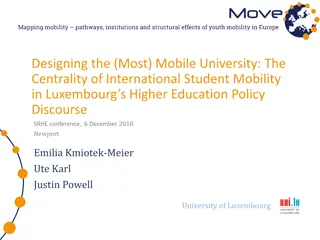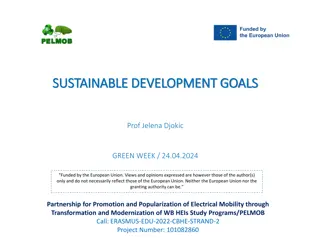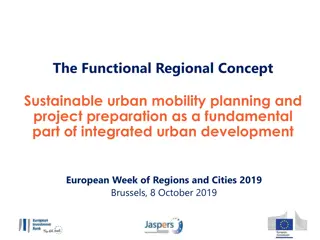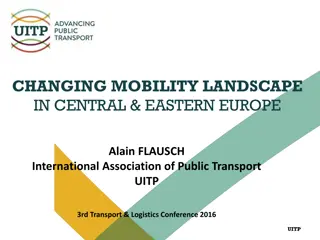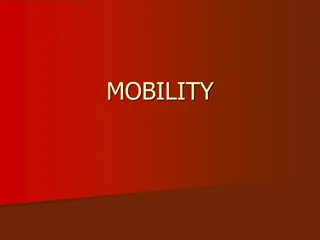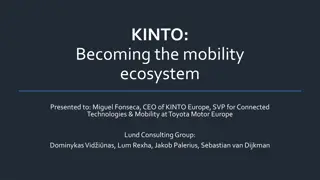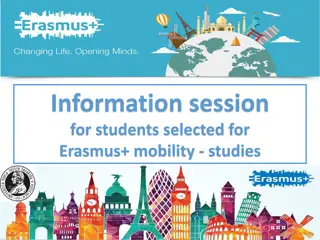Regional E-Mobility Policy Roadmap for PICs: A WB Study
The World Bank commissioned a study to develop a regional e-mobility policy roadmap for the Pacific Island Countries (PICs), focusing on the feasibility of large-scale electric vehicle (EV) deployment. Assessing e-mobility status, grid impact, cost-benefit analysis, and policy recommendations, the study highlights the potential and barriers of EV uptake in PICs, with electric cars, motorbikes, and vans showing the most promise. Despite low current uptake, there is considerable potential for e-mobility growth in the region.
Download Presentation

Please find below an Image/Link to download the presentation.
The content on the website is provided AS IS for your information and personal use only. It may not be sold, licensed, or shared on other websites without obtaining consent from the author. Download presentation by click this link. If you encounter any issues during the download, it is possible that the publisher has removed the file from their server.
E N D
Presentation Transcript
WB Study on PIC E-mobility Roadmap November 29, 2022 Inchul Hwang WB IEAE1
Contents 1. Introduction 2. Impact of e-mobility on electricity systems 3. Economic viability of e-mobility 4. Policy recommendations 2
Objective: develop a regional e-mobility policy roadmap for the PICs The WB contracted ECA and TTA to develop a regional e-mobility policy roadmap for the PICs Funded by the WB s Korea Green Growth Trust Fund (KGGTF) The focus of the roadmap is on assessing the feasibility of large- scale EV deployment in the PICs, with particular consideration given to high levels of VRE in the electricity systems The roadmap aims to provide concrete policy recommendations and technical guidelines to support the PICs in promoting a transition to sustainable, decarbonised transport Tasks: The current status of e-mobility, grid impact assessment, cost-benefit analysis, barriers to e-mobility uptake, policy recommendations and technical guidelines/standards for EV charging and maintenance 4
Status: E-mobility uptake remains low, but there is considerable potential Vehicle ownership in the PICs is low and the distances travelled tend to be short, which has led to low e-mobility uptake at the moment Potential e-mobility uptake in the PICs Electric cars High, particularly for taxis and high-use customers However, short distances mean that virtually all trips can be conducted with less than a single charge. And fuel is expensive Electric motorbikes High, in countries where motorbikes are already used Electric vans and trucks Potential uptake varies a lot by EV type, based on how mature the technologies are and their suitability for users in each PIC High for delivery vans and transport, low for trucks Electric buses Low unless heavily subsidised Overall, electric cars, motorbikes, and vans have the most potential in the short to medium-term future Electric boats Low Micro e-mobility Moderate to high, with only small barriers to entry 5
Prospect: The expected uptake is uncertain, but will likely not exceed 10% by 2030 Electric cars Estimates suggest that globally at least 10% of cars will be EVs by the end of the decade Exact uptake rates are difficult to estimate given uncertainties about future technology costs and policies Uptake is generally expected to be slower in low and middle-income countries due to a reliance on second-hand vehicles and lower incomes Potential electric car uptake in PICs 20% 18% 16% 14% Evs as % of all vehicles ECA/TTA estimates that the share of electric cars in the PICs will be 6-19% of all cars in 2030, based on 20%-60% EV share in new vehicle sales. Actual uptake is likely to be at the lower end of this range 12% 10% 8% Electric motorbikes 6% Uptake could be high in countries already using two-wheelers, as low-cost models enter the market 4% 2% Electric vans - 2022 2023 2024 2025 2026 2027 2028 2029 2030 Uptake of electric vans likely limited to small goods transport and public transport 20% of sales in 2030 are EV 40% of sales in 2030 are EV 60% of sales in 2030 are EV 6
Four groups and sample countries Grouping of PICs There is significant diversity across the 11 PICs Category Countries Key (relative) characteristics Likely main types of e-mobility Large markets Fiji Large (in size and population) Electric cars (private, taxis) To ensure the analysis and recommendations reflect this diversity, while also being informed by detailed analysis, the PICs are grouped into four categories and selectone country from each to analyse Samoa Wealthy Electric vans (taxis, commercial) High vehicle ownership Cheap electricity Intermediate markets Vanuatu Large (in size and population) Electric cars (taxis) Solomon Islands Less wealthy Electric vans (commercial) Tonga Low vehicle ownership Small islands Kiribati Small (short distances) Electric cars (taxis) FSM Low vehicle ownership Sample countries analysed in grid impact and economic viability assessments: Fiji, Solomon Islands, Marshall Islands, Tuvalu Electric motorcycles Marshall Islands Palau Very small islands Nauru Very small (short distances) Electric motorcycles and electric scooters Tuvalu Very small markets 7
2. Impact of e-mobility on electricity systems
The impact of EVs on electricity demand will vary by country, based on car ownership & electricity demand Expected impacts of EV uptake on electricity demand in the PICs are expected to vary, as shown in the analysis of four countries Increase in total electricity demand due to e-mobility uptake Fiji impacts are relatively high (5% increase in demand for 10% EV uptake) due to higher car ownership and average distances travelled daily (~30km/car/day) Percentage impacts in Solomon Islands are also high (6% demand, 10% EV uptake) due to low existing electricity demand per customer, which counteracts its low car ownership Impacts on the Marshall Islands and Tuvalu are very low because car ownership is low (for example Tuvalu has only 65 registered cars) As a general rule for the large and intermediate markets, every 1% uptake in e- mobility will lead to an approximate 0.5% increase in electricity demand 9
Solar + BESS and daytime charging will be the most efficient way to meet EV demand Assumed levelised costs of different generation types A combination solar+BESS is currently more expensive than solar+diesel generation (although not by much at current fuel prices) Massive investment needed for solar + BESS and network upgrades will be a challenge, but it is expected to change by 2030 as the cost of solar and BESS capacity continues to fall It will be much cheaper to supply EV demand during sunshine hours than non-sunshine hours, by a factor of more than two in some cases This is true even after accounting for the fact that network costs are mostly incurred during weekday business hours Because most PICs currently typically face peak demand during the middle of the day, driven by commercial air- conditioning 2030 marginal cost of supplying EV demand efficiently (US$/kWh) Solomon Islands Marshall Islands Fiji Tuvalu Peak + sunshine hours (weekday, daytime) Peak + non-sunshine hours (weekday early evening) 0.17 0.19 0.26 0.21 0.30 0.19 0.54 0.43 Off-peak + sunshine hours (weekend daytime) 0.11 0.13 0.18 0.15 Off-peak + non-sunshine hours (nighttime) 0.25 0.13 0.46 0.38 10
Much more solar is needed to improve EV business Most Pacific electricity systems have high solar potential but have underbuilt solar and therefore rely on diesel-fired generation Current generation mix in PICs Diesel generation (which is expensive and has high emissions) is currently the marginal generator in most countries, so is used to supply any new EV charging demand This limits the viability of EVs, as it leads to high charging costs and limited environmental benefits Fiji and Samoa are well placed to displace diesel through a combination of solar and hydro, but only if they invest more heavily in solar than planned 2030 electricity supply curve in Fiji after adding 50MW solar Other PICs will need to add a lot of solar and BESS to regularly push diesel off the margin. Network upgrades might be pursued at the same time. 11
The more daytime charging, the cheaper the cost of supplying EVs Without incentives encouraging otherwise, residential consumers will likely prefer to charge at home, typically through trickle charging from a standard electrical outlet This would lead to a predominance of overnight charging, which would ease demands on generation and network capacity in the short-term But would be sub-optimal once the utilities invest more heavily in solar generation If EV demand is met with solar+BESS demand (instead of hydro), then overnight EV charging will be around 50% more expensive than daytime charging Daytime charging can be encouraged through time-of-use (TOU) tariffs and by installing public charging facilities Possible EV charging demand curves 2030 marginal costs of supplying EV demand 12
Net benefits calculated under low, medium, high use cases Once governments know what is beneficial to society, they can implement policies that aligning societal benefits with individual financial incentives (eg. through tax breaks to reflect environmental benefits) Overview of scenarios and assumptions considered in cost-benefit analysis Based on status quo No further policy interventions beyond status quo Business- as-usual 2022 The viability of EVs is calculated by comparing EV and ICE costs: Upfront costs for vehicles and charging infrastructure Fuelling/charging costs Maintenance costs Environmental costs from vehicles and electricity generation Conservative assumptions reduction in EV upfront costs Only 20% of daytime EV charging supplied by solar. Use of diesel outside of sunshine hours Mostly overnight EV charging Business- as-usual 2030 Higher future cost reductions in EV upfront costs 100% of daytime EV charging supplied by solar, thanks to increase RE investment. And 80% use of BESS (charged by solar) outside of sunshine hours More daytime EV charging, thanks to TOU tariffs and provision of public charging facilities Net benefits are calculated under three distinct scenarios. Low, medium, and high-use cases for each EV Type (eg. taxis = high-use e-cars) are evaluated To reflect that some vehicles are used more than others, which will impact how much lower operating costs offset higher upfront costs Favourable 2030 14
EVs will become viable if countries increase solar generation and encourage daytime charging Despite forecast significant reductions in their upfront costs, e-cars, e-motorbikes, and e-vans are all unlikely to be viable by 2030 if countries do not make significant investments in solar generation Viability of EVs under certain use cases under the Favourable 2030 scenario If the PICs successfully increase solar penetration, then EVs will be viable, except for when the usage is low This also depends on countries implementing incentives to encourage daytime charging (to benefit from cheap and clean solar energy) The higher benefits in the medium and high use cases (ie. commuters and taxis), suggests policies should focus on encouraging EV uptake among these groups In Tuvalu and other very small islands, EVs are unlikely to become viable in the short to medium term The short distances travelled do not allow the high upfront costs of EVs to be recouped through lower operating costs 15
Barriers to e-mobility uptake in the PICs While there is variation between countries, the barriers shown in bold are generally the most impactful Key barriers to e-mobility uptake in the PICs Transport and electricity infrastructure Not all of these can be easily mitigated, in particularly those relating to commercial viability. But as demand grows, private sector will bring more cheaper second-hand EVs to market A Lack of electricity charging infrastructure B Dependency on diesel-fired electricity production and resulting high tariffs C Lack of technical support and adequate maintenance services for EVs D Limited environmental benefits given reliance on diesel generation for electricity E Electricity grid has limited capacity for electricity charging infrastructure Commercial viability F Price gap between the upfront cost of EVs and ICE, with demand in the PICs very sensitive to price The reliance on diesel-fired electricity generation will take time to mitigate, but is critical. Decarbonisation of transport and electricity must happen in tandem G Small trip distances limits operating cost savings H Reliance on second-hand vehicles and the limited second-hand EV market I Limited financing options for investment in infrastructure and EV fleets J Limited fiscal capability to subsidise EV uptake Governance and policy Policy-makers should give all barriers some attention, because many are inter-dependent K No clear e-mobility strategy or roadmap L Limited coordinated efforts between the Pacific Island Countries Regulation and standards Unfortunately, smaller PICs will generally have a lower ability to act mitigate barriers M Absence of regulations and standards relating to EVs Communication and awareness N Limited experience and training with EVs O Limited understanding of quality standards of EVs and associated products 17
Recommendations Transport/electricity infrastructure Potential impact Fiscal affordability Ease of implementation Overall priority # Policy recommendation 1 Develop public electric charging infrastructure High Medium Medium High 2 Support the development of in-house EV charging facilities Medium Medium Medium Medium 3 Roll-out electricity smart meters High Low Medium High 4 Require charging facilities in new buildings Low-Medium High High Medium 5 Expand RE and BESS capacity High Low Low High 6 Introduce electricity time-of-use tariffs High Medium Medium High 7 Foster development of private PV facilities to charge EVs Medium High Medium Medium 8 Conduct impact assessments of EV uptake on distribution grids Medium Medium Medium Medium 9 Offer special EV access Low-medium Medium High Low Many of these are interrelated and are focused on enabling daytime EV charging using cheap solar generation Some are contingent on others and should not necessarily be implemented immediately. For example introducing time-of-use tariffs requires roll-out of smart meters and should not be implemented until RE capacity has been expanded 18
Recommendations Commercial viability Potential impact Fiscal affordability Ease of implementation Overall priority # Policy recommendation 10 Provide purchase incentives, such as subsidies or tax breaks High Low Medium High Offer targeted financial incentives for private companies to establish EV fleets 11 Medium-High Medium Medium Medium These are focused on reducing the upfront cost differential between electric and ICE vehicles and fairly reflecting the environmental benefits of EVs Policy makers should hold off introducing large purchase incentives until their national electricity system can charge EVs from renewable sources 19
Recommendations Governance and policy Potential impact Fiscal affordability Ease of implementation Overall priority # Policy recommendation 12 Create a regional e-mobility council Medium High High High 13 Develop a regional e-mobility strategy Medium Medium High High 14 Develop national e-mobility strategies Medium High High High 15 Monitor progress made on e-mobility Low High High Medium 16 Coordinate planning across public administrations Low High Medium Medium This roadmap provides a starting point for regional and national e-mobility strategies Such strategies should be developed by local stakeholders to ensure that they have ownership over the policy 20
Recommendations Regulations and standards Potential impactFiscal Ease of implementation Overall priority # Policy recommendation affordability 17 Establish regulatory instruments for EVs Medium High Low-medium Medium 18 Develop technical guidelines for EV charging Low-medium High High Medium 19 Establish minimum standards for EVs and charging equipment Low-medium High High High 20 Develop public procurement procedures for EV products Low-medium High High Medium Technical annexes to the report, which can be used as a starting point for national guidelines and standards, include: Technical guidelines for EV charging stations Minimum standards for EV charging equipment Guidelines for EV maintenance procedures 21
Recommendations Communication and awareness Potential impact Fiscal affordability Ease of implementation Overall priority # Policy recommendation 21 Develop an e-mobility communication strategy Medium High Medium High 22 Engage with stakeholders Medium High Medium Low 23 Launch EV pilot projects Medium Medium Medium Medium 24 Switch public vehicle fleets to e-mobility Medium Low Short term Low 25 Provide training and information on e-mobility Medium High Medium Medium 26 Mainstream gender aspects in EV policy Low High Medium Medium An e-mobility communication strategy will be a key step in the implementation of regional and national e-mobility strategies 22








